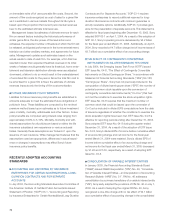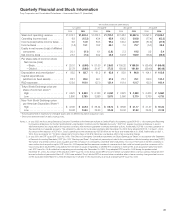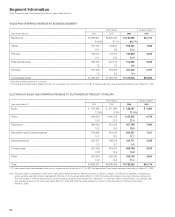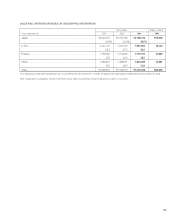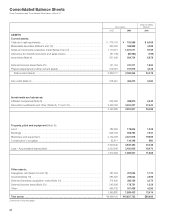Sony 2006 Annual Report Download - page 79
Download and view the complete annual report
Please find page 79 of the 2006 Sony annual report below. You can navigate through the pages in the report by either clicking on the pages listed below, or by using the keyword search tool below to find specific information within the annual report. 77
statement of income, and Sony’s assets and liabilities increased
by ¥95.3 billion and ¥98.0 billion, respectively. These increases
were treated as non-cash transactions in the consolidated
statement of cash flows. In addition, cash and cash equivalents
increased by ¥1.5 billion.
Sony subsequently early adopted the provisions of FIN No. 46
R, which replaced FIN No. 46, upon issuance in December 2003.
The adoption of FIN No. 46 R did not have an impact on Sony’s
results of operations and financial position or impact the way
Sony had previously accounted for VIEs.
■EXCHANGES OF NONMONETARY ASSETS
In December 2004, the FASB issued FAS No. 153, “Exchanges
of Nonmonetary Assets, an amendment of Accounting Principle
Board Opinion (“APB”) No. 29”. This statement requires that
exchanges of productive assets be accounted for at fair value
unless fair value cannot be reasonably determined or the
transaction lacks commercial substance. This statement is
effective for nonmonetary asset exchanges that have occurred
in the fiscal periods beginning after June 15, 2005. Sony
adopted FAS No.153 on July 1, 2005. The adoption of FAS
No.153 did not have a material impact on Sony’s results of
operations and financial position.
■ACCOUNTING FOR CONDITIONAL ASSET RETIREMENT
OBLIGATIONS
In March 2005, the FASB issued FIN No. 47, “Accounting for
Conditional Asset Retirement Obligations—an Interpretation of
FAS No. 143.” FIN No. 47 clarifies that an entity is required to
recognize a liability for the fair value of a conditional retirement
obligation when incurred if the liability’s fair value can be reason-
ably estimated. FIN No. 47 also clarifies when an entity would
have sufficient information to reasonably estimate the fair value
of an asset retirement obligation. This interpretation is effective
no later than the end of fiscal years ending after December 15,
2005. Sony adopted FIN No. 47 on March 31, 2006. The
adoption of FIN No. 47 did not have a material impact on Sony’s
results of operations and financial position.
■DETERMINING WHETHER TO AGGREGATE OPERATING
SEGMENTS THAT DO NOT MEET THE QUANTITATIVE
THRESHOLDS
In September 2004, the EITF issued EITF Issue No. 04-10,
“Applying Paragraph 19 of FASB Statement No. 131, Disclo-
sures about Segments of an Enterprise and Related Information,
in Determining Whether to Aggregate Operating Segments That
Do Not Meet the Quantitative Thresholds.” EITF Issue No. 04-10
clarifies how an enterprise should evaluate the aggregation
criteria in paragraph 17 of FAS No. 131 when determining
whether operating segments that do not meet the quantitative
thresholds may be aggregated in accordance with paragraph 19
of FAS No. 131. EITF Issue No. 04-10 is effective for fiscal years
ending after September 15, 2005. Sony adopted EITF Issue
No. 04-10 during the fiscal year ended March 31, 2006. The
adoption of EITF Issue No. 04-10 did not have an impact on
Sony’s results of operation and financial position.
RECENT PRONOUNCEMENTS
■ACCOUNTING FOR STOCK-BASED COMPENSATION
In December 2004, the FASB issued FAS No. 123 (revised 2004),
“Share-Based Payment” (“FAS No. 123(R)”). This statement
requires the use of the fair value based method of accounting
for employee stock-based compensation and eliminates the
alternative use of the intrinsic value method prescribed by APB
No. 25. With limited exceptions, FAS No. 123(R) requires that
the grant-date fair value of share-based payments to employees
be expensed over the period the service is received. Sony has
accounted for its employee stock-based compensation in
accordance with the provisions prescribed by APB No. 25 and
its related interpretations and has disclosed the net effect on net
income and net income per share allocated to the common
stock if Sony had applied the fair value recognition provisions of
FAS No. 123 to stock-based compensation as described in
Note 2 of Notes to the Consolidated Financial Statements (2)
Significant accounting policies—Stock-based compensation.
Sony adopted FAS No. 123(R) on April 1, 2006. Sony has elected
the modified prospective method of transition prescribed in FAS
No. 123(R), which requires that compensation expense be
recorded for all unvested stock acquisition rights as the requisite
service is rendered beginning with the first period of adoption.
As of March 31,2006, the aggregate value of the unvested stock
acquisition rights was ¥4.4 billion. Sony expects the total
expenses to be recorded in the future periods will be consistent
with the pro forma information shown in Note 2 of Notes to
Consolidated Financial Statements (2) Significant accounting
policies—Stock-based compensation.
■INVENTORY COSTS
In November 2004, the FASB issued FAS No. 151, “Inventory
Costs, an amendment of ARB No. 43, Chapter 4.” This state-
ment requires certain abnormal expenditures to be recognized
as expenses in the current period. It also requires that the
amount of fixed production overhead allocated to the costs of
conversion be based on the normal capacity of the production
facilities. This statement shall be effective for fiscal years
beginning after June 15, 2005, with early adoption during the











